The meaning extension of over: A critique of key theories
This paper summarizes different approaches to the meaning extension of the English
preposition over and proposes a multimodal approach comprising three spatial image theories and one
mental space theory in reference to an image-based view. It is concluded that the author’s proposal is a
combination of Deane’s 2005 multimodal spatial representations and 2017 Kövecses’s model, in which
there is an emphasis that treating the spatial configurations of a spatial marker requires different frames
and when the marker denotes a non-spatial sense, there exists an activation of a metaphor layered from its
frame in certain context with a specific communicative purpose to the domain of which the frame is a part
and finally the activation will reach the image schema that supports the frame.
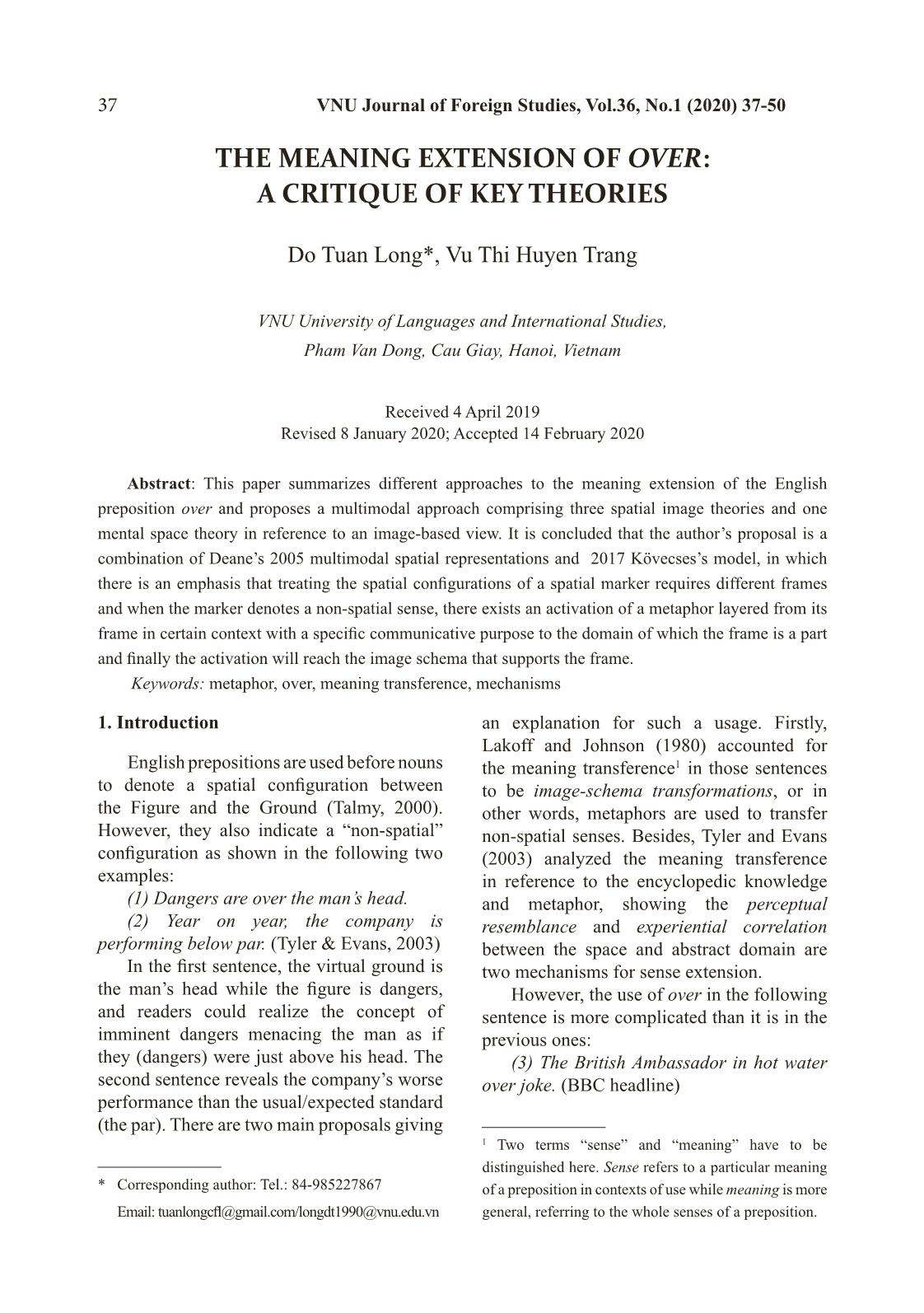
Trang 1
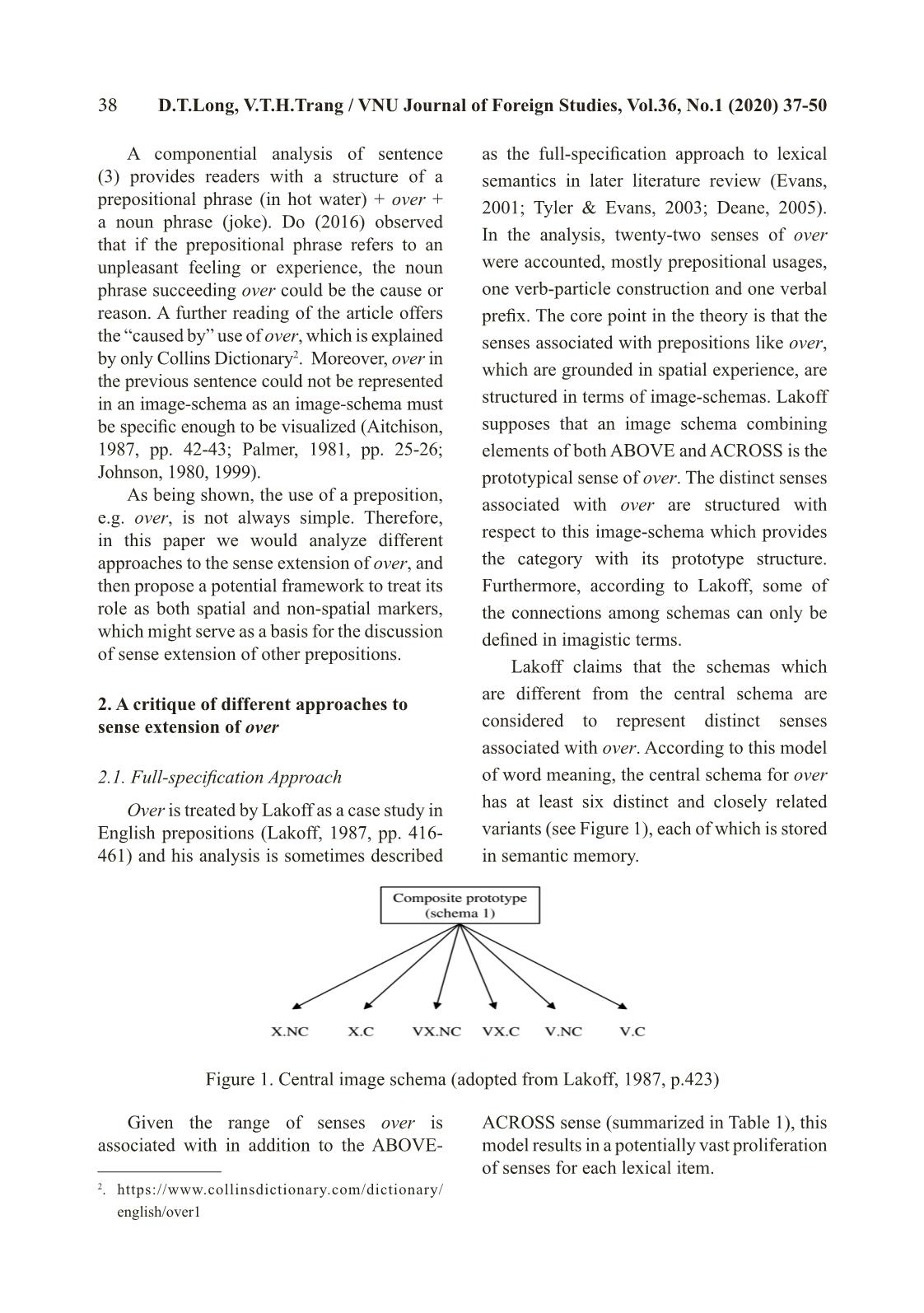
Trang 2
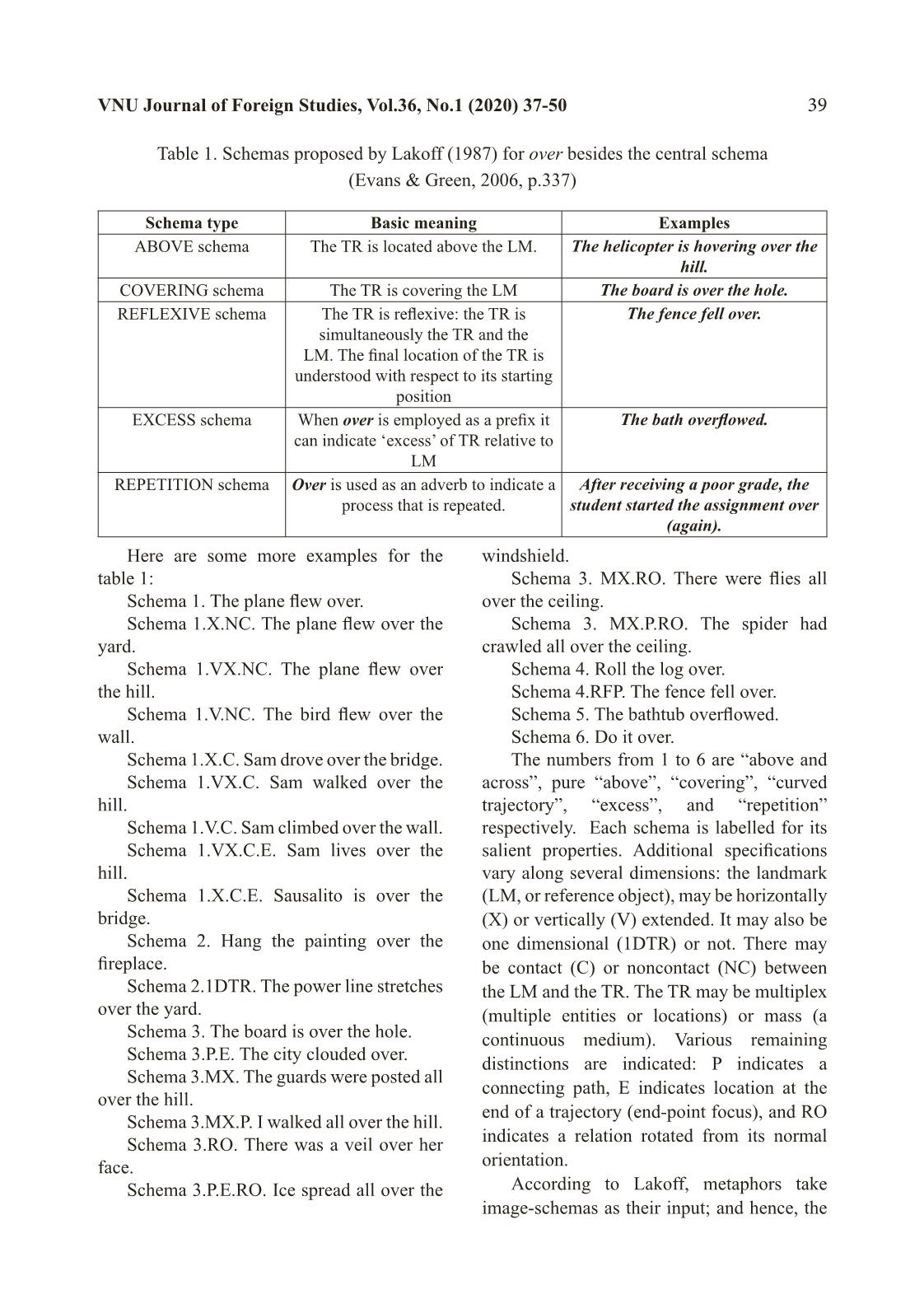
Trang 3
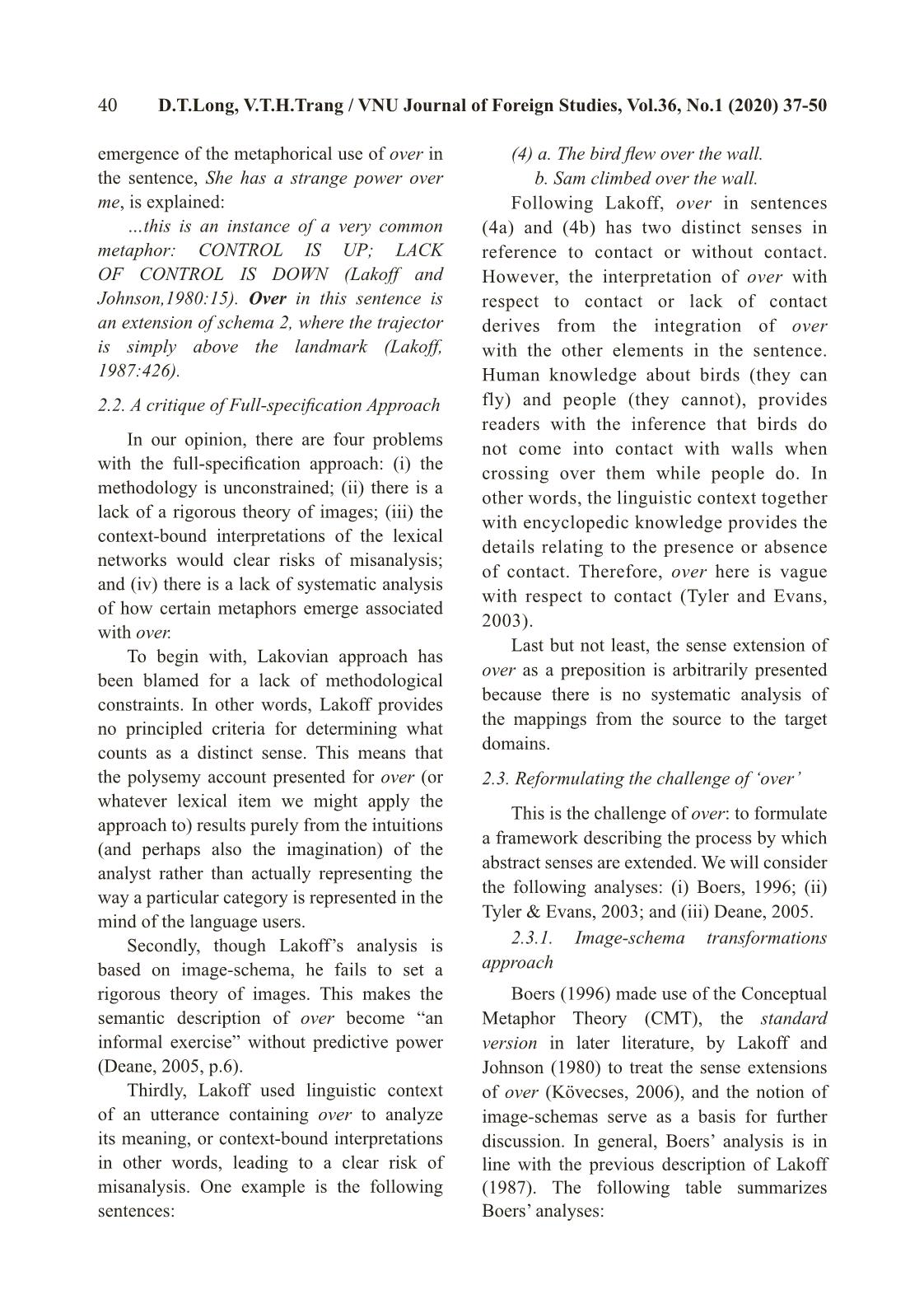
Trang 4
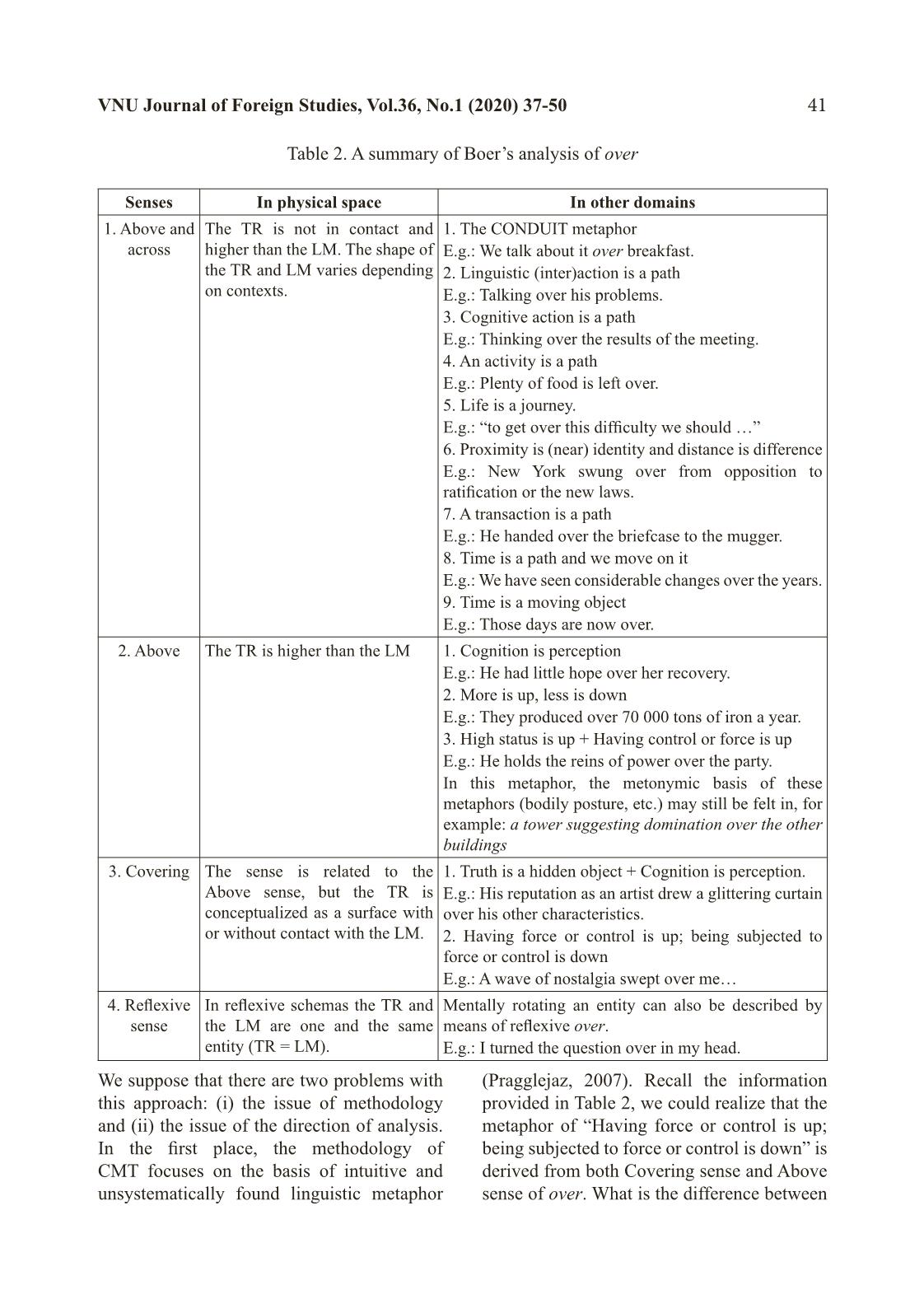
Trang 5
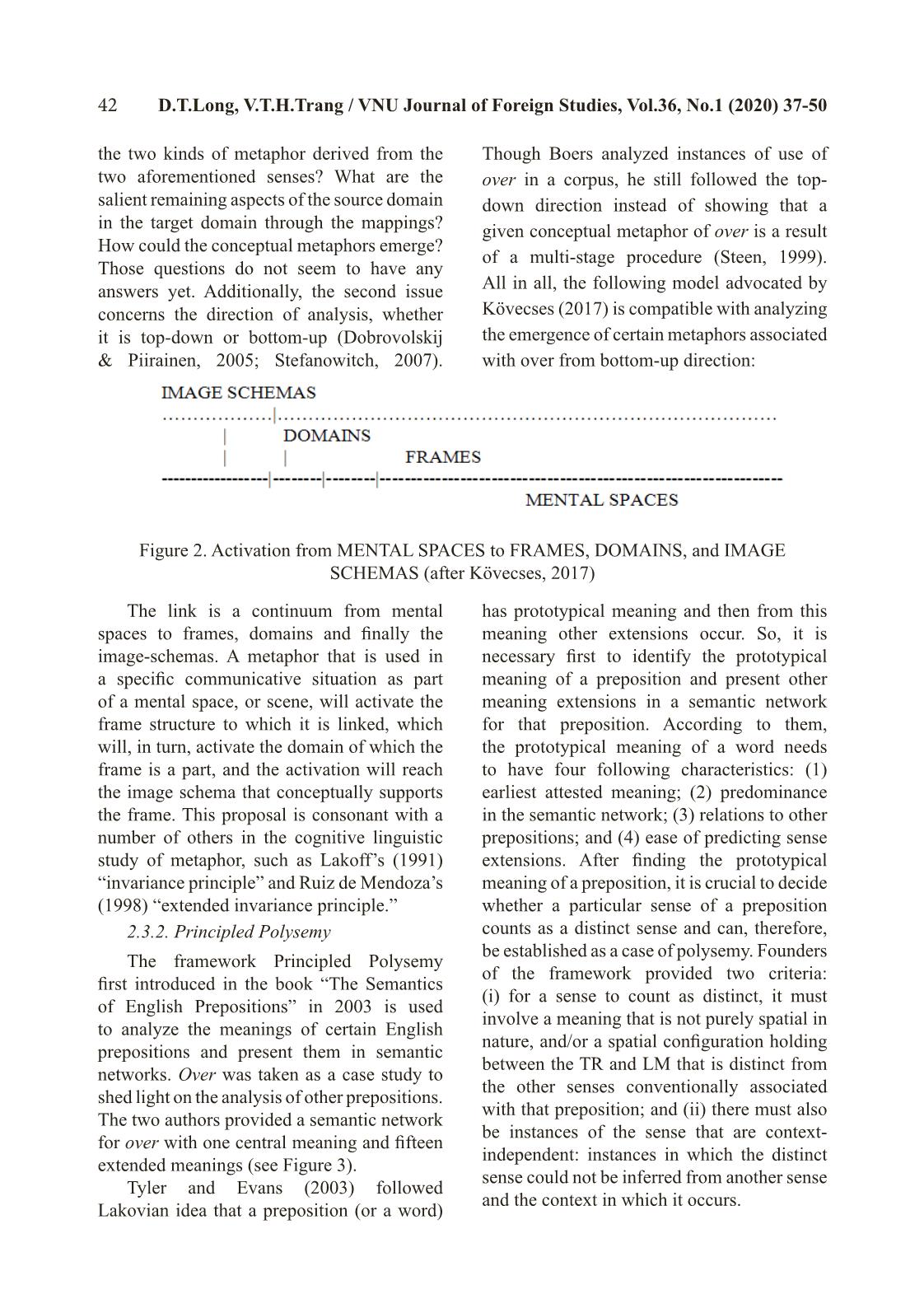
Trang 6
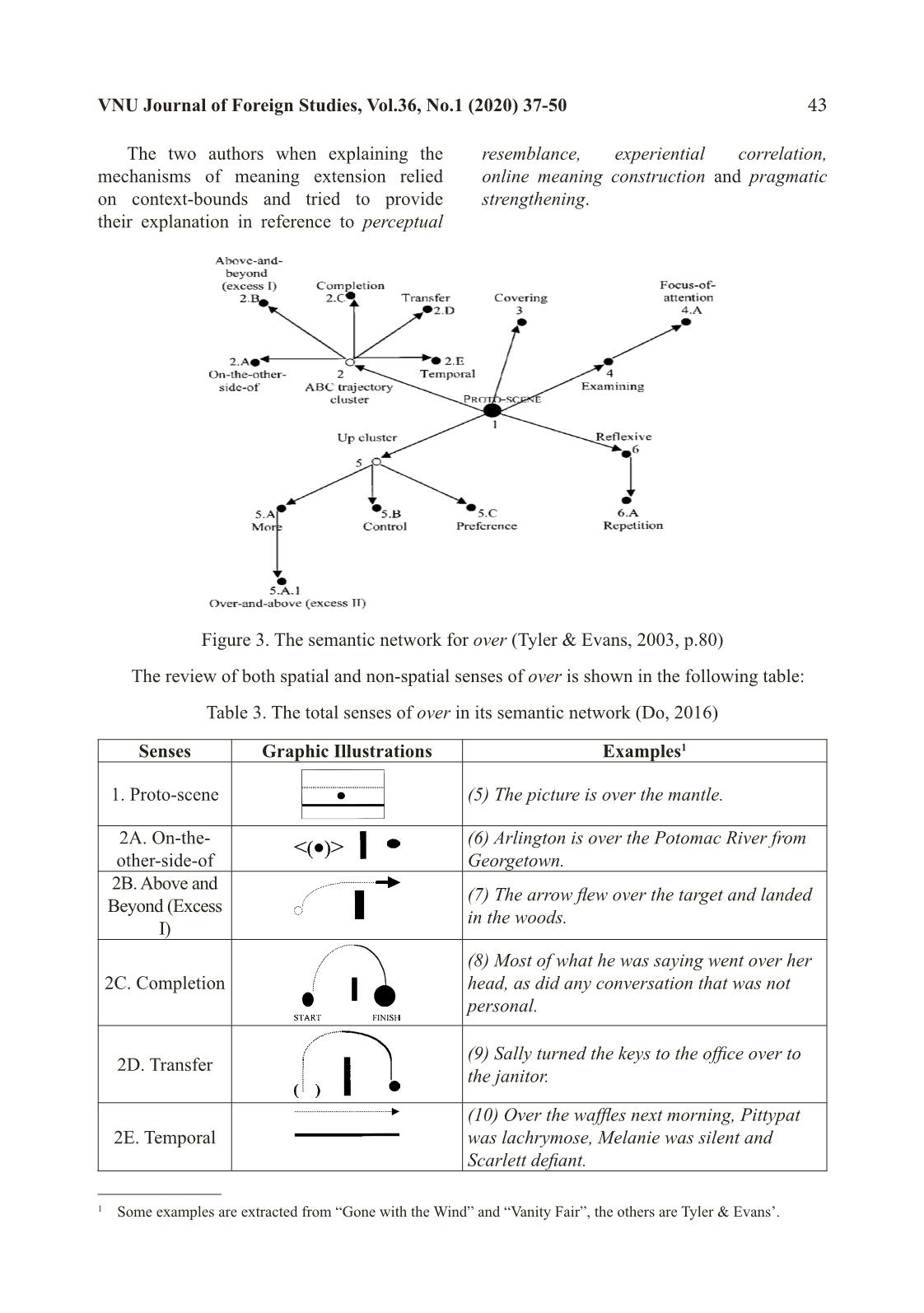
Trang 7
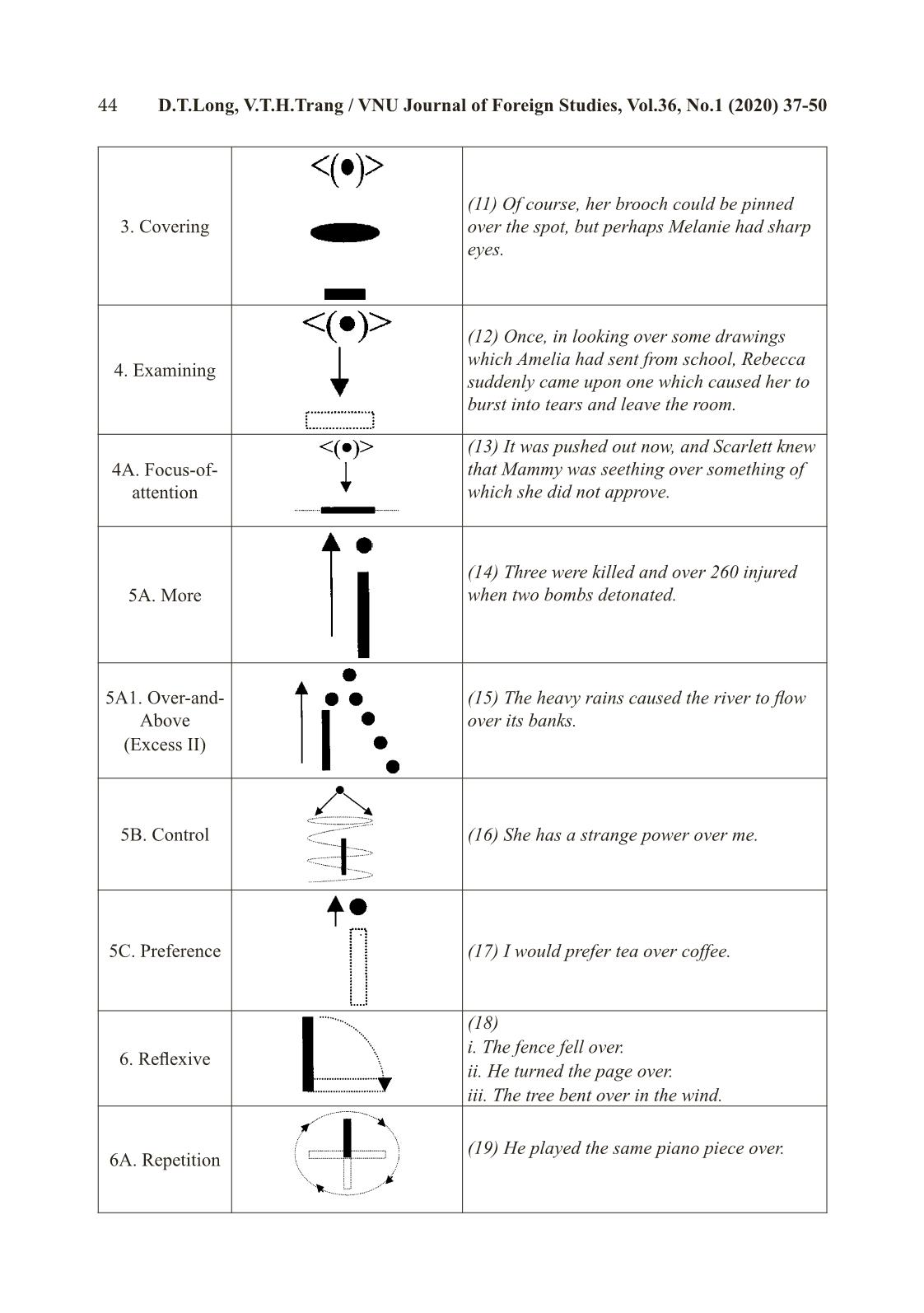
Trang 8
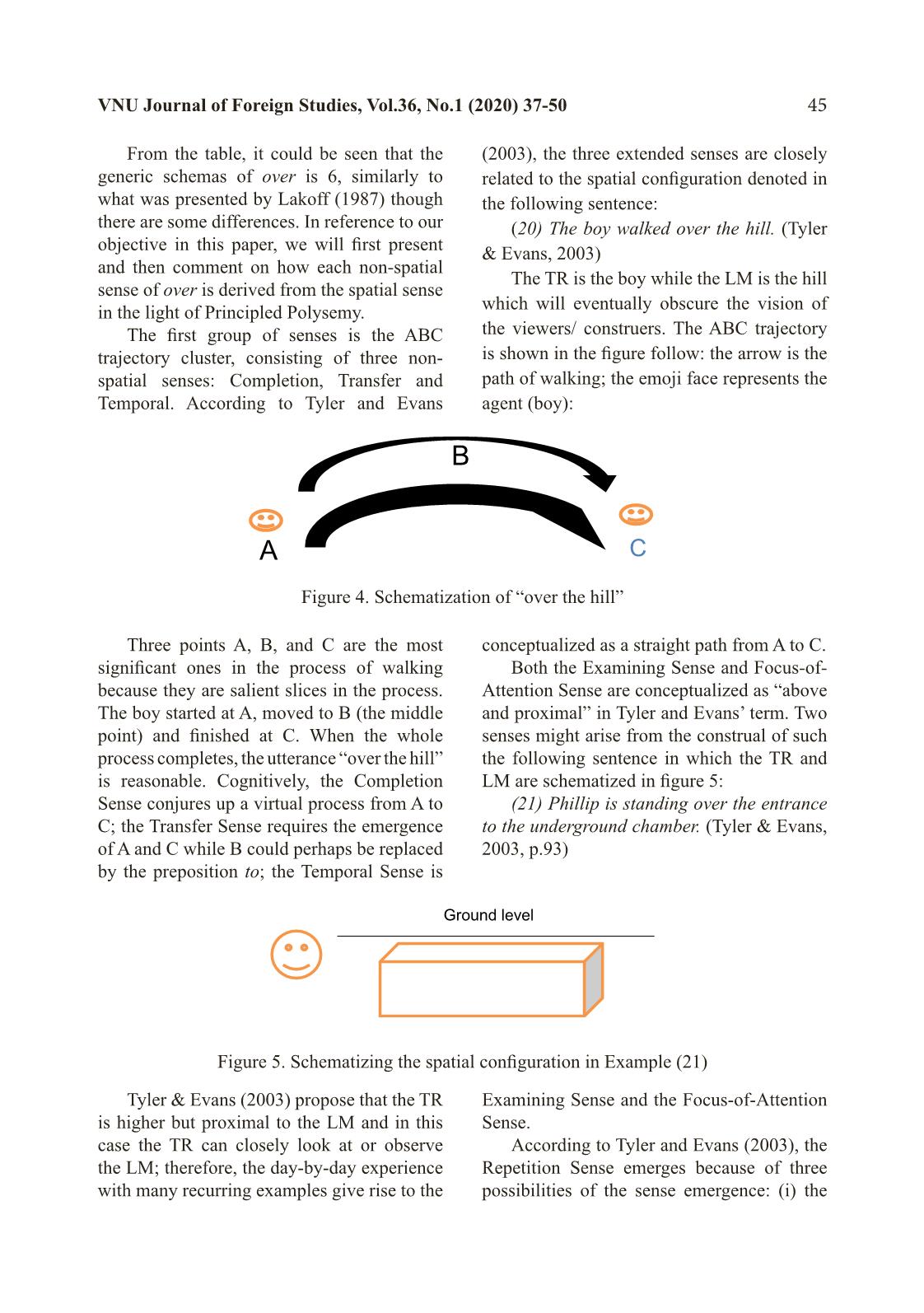
Trang 9
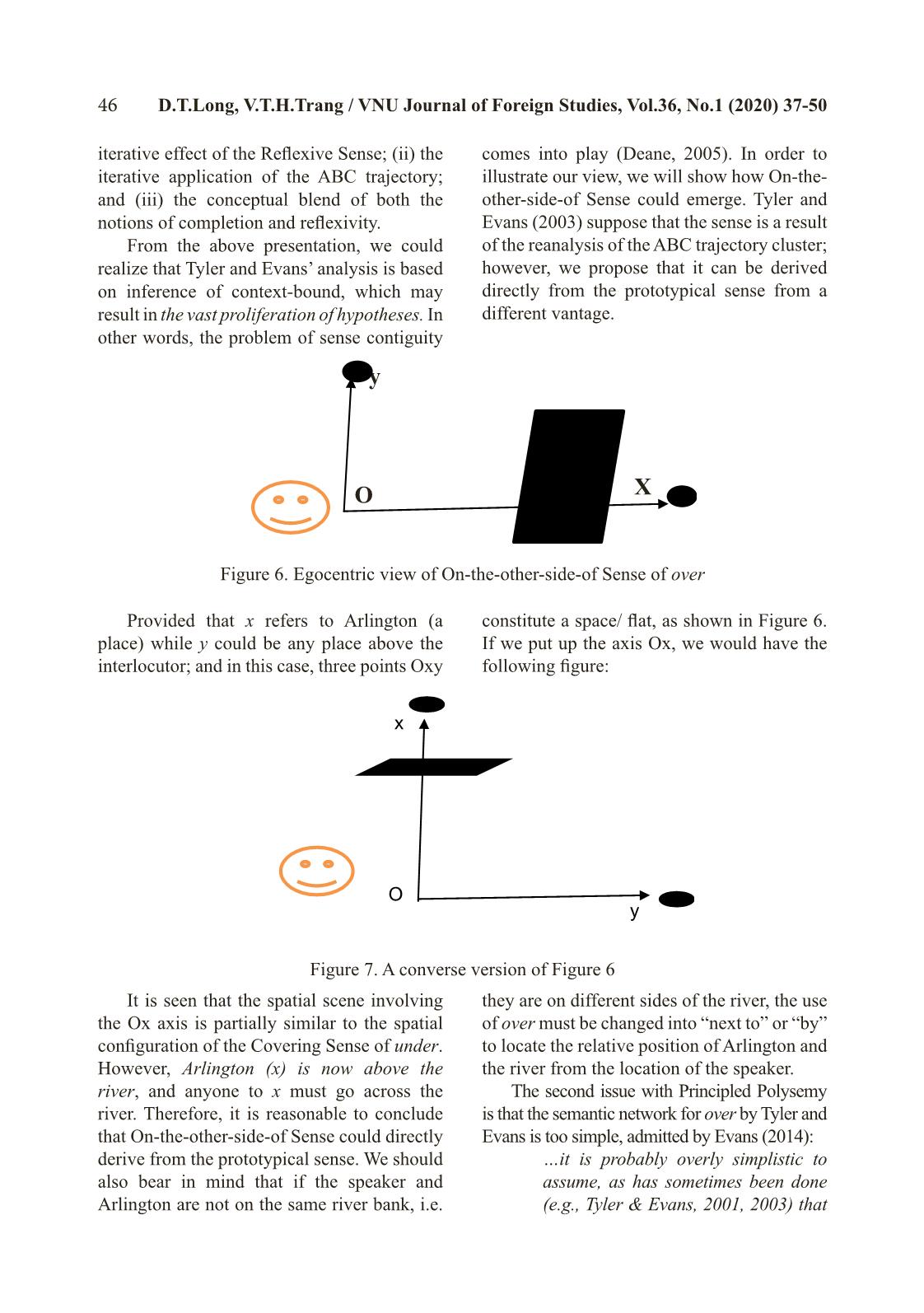
Trang 10
Tải về để xem bản đầy đủ
Tóm tắt nội dung tài liệu: The meaning extension of over: A critique of key theories
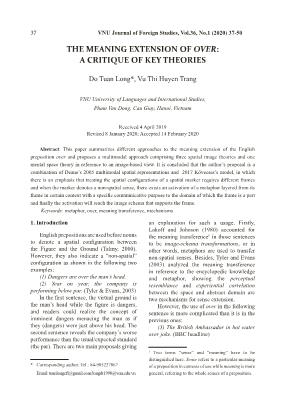
s image-complexes); the kinetic space (in reference to action and force dynamics); and the maneuver space (in reference to Orientation and Alignment). Particularly, Deane’s model of Multimodal Image Theory is backed up by three principles in three aforementioned frames: (i) Preference rule principle: A variant construal may be formed by combining a subset of images from the prototype. (ii) Stereoscopic Principle: Representations employing object-centered fields are stereoscopic images, and must therefore consist of at least two images which represent the same scene but differ in the coordinates or resolution from which they view the scene. (iii) Distinctiveness Principle: If an image or an image-complex is part of the prototype for a preposition, it cannot be used as a semantic variant of another preposition. It is seen that the number of distinct senses associated with English prepositions is reducing systematically. Details of the senses denoted by over are discussed by Deane (ibid: 42-90). In fact, the model advocated by Deane has successfully bridged the gaps that previous approaches left. Firstly, it presents the sense development of over as a system from the prototypical sense to extended ones through three aforementioned principles, showing that the interpretation of over is a multi-stage cognitive process. Distinct sense, e.g. On-the-other-side-of or Covering sense presented by Tyler and Evans, are variants of the prototypical sense. Secondly, the framework has rigorous constraints on what counts as distinct sense, solving the issue of sense redundancy. However, the non-spatial senses of over are not treated in the light of Multimodal Space Image Theory. Therefore, in order to explain how non-spatial senses of over develop from spatial ones, there is a need of a combination between space and non- space frames of analysis. 3. Conclusion In conclusion, regarding the goal of the paper, we have reviewed four notable works to treat over by different scholars (Lakoff, 1987; Boers, 1996; Tyler & Evans, 2003; Deane, 2005). The Full-specification approach advocated by Lakoff is criticized for failing to set a theoretical constraint and no advance was shown in comparison with purely descriptive account. The Principled Polysemy framework introduced by Tyler and Evans (2003) provides rigid constraints to determine 48 D.T.Long, V.T.H.Trang / VNU Journal of Foreign Studies, Vol.36, No.1 (2020) 37-50 the prototypical sense of spatial prepositions, and to count a sense as distinct. However, this framework is also claimed to be too simple, as admitted by Evans (2014). Boers’ (1996) top-down analysis of conceptual metaphors associated with over seems to be arbitrary and could not show spatial cognition is a multi- stage process. Last but not least, the model of Multimodal Spatial Representations by Deane (2005) proves to be successful, solving the remaining issues that other accounts left. It is suggested that the image-schema based view of over is an appropriate approach including four spaces: the visual space (spatial relations as image-complexes); the kinetic space (in reference to action and force dynamics); the maneuver space (in reference to Orientation and Alignment); and the mental space (in reference to virtual relations between figure and ground, in which CMT is the analysis tool). In other words, we advocate a combination between Multimodal Spatial Representations (Deane, 2005) and Mental Space from bottom-up direction (Kövecses, 2017) to treat the issue raised in the paper. References Aitchison, J. (1987). Words in the Mind: An Introduction to the Mental Lexicon. Oxford/ New York: Basil Blackwell. Barcelona, A. (2003). Metaphor and metonymy at the Crossroads: A cognitive perspective. Berlin: Mouton De Gruyter. Brugman, C. (1981). The story of OVER. Unpublished MA thesis, University of California: Berkeley. Boers, F. (1996). Spatial Prepositions and Metaphor: A Cognitive-semantic Journey along the UP-DOWN and the FRONT-BACK Dimensions. Tübingen: Gunter Narr. Brenda, M. (2014). The Cognitive Perspective on the Polysemy of the English Spatial Preposition over. Cambridge: Cambridge Scholars Publishing. Coventry, K. R., Richard, C. & Simon, C. G. (1994). Spatial prepositions: object specific function and task requirements. Journal of Semantics,11(4), 289–309. Croft, W. & Cruise, A. D. (2004). Cognitive Linguistics. Cambridge: Cambridge University Press. Deane, P. D. (2005). Multimodal spatial representation: on the semantic unity of over. In From Perception to Meaning: Image Schemas in Cognitive Linguistics, Beate, H. & Grady, J. (eds), 235–284. Berlin/New York: Mouton de Gruyter. Dewell, R. B. (1994). Over again: Image-schema transformations in semantic analysis. Cognitive Linguistics, 5(4), 351–380. Dobrovolskij, D., & Piirainen, E. (2005). Figurative Language: Cross-cultural and Cross-linguistic Perspective. Amsterdam: Elsevier. Evans, V. (2004). The Structure of Time: Language, Meaning and Temporal Cognition. Amsterdam: John Benjamins. Evans, V. (2005). The meaning of time: polysemy, the lexicon and conceptual structure. J. Linguist, 41(1), 33-75. Evans, V. (2006). Lexical concepts, cognitive models and meaning-construction. Cognitive Linguist, 17(4), 491-534. Evans, V. (2009). How Words Mean: Lexical Concepts, Cognitive Models and Meaning Construction. Oxford: Oxford University Press. Evans, V. (2010a). From the spatial to the non-spatial: the ‘state’ lexical concepts of in, on and at. In: Evans, V., Chilton, P. (Eds.), Language, Cognition & Space, 215-248. London: Equinox. Evans, V. (2010b). Figurative language understanding in LCCM Theory. Cognitive Linguist, 21(4), 601-662. Evans, V. (2013). Language and Time: A Cognitive Linguistics Approach. Cambridge: Cambridge University Press. Evans, V. (2014). A unified account of polysemy within LCCM Theory. Lingua, 157, 100-123. Evans, V. (2015). What’s in a concept? Analog versus parametric concepts in LCCM Theory. In: Margolis, E., Laurence, S. (Eds.), The Conceptual Mind: New Directions in the Study of Concepts. Cambridge, MA: MIT Press. Evans, V., & Green, M (2006). Cognitive Linguistics: An Introduction. Edinburgh: Edinburgh University Press. Evans, V., & Tyler, A. (2004). Rethinking English prepositions of movement: the case of to and through. Belg. J. Linguist, Vol 18, 247-270. Fauconnier, G. (1985). Mental Spaces. Cambridge: Cambridge University Press. Fauconnier, G., & Turner, M. (1998). Conceptual integration networks. Cognitive Science, 22(2), 31-187. Fauconnier, G., & Turner, M. (2002). The way we think: Conceptual Blending and the Mind’s Hidden Complexities. New York: Basic Books. Fillmore, C. (1982). Frame semantics. In Linguistics in the Morning Calm, ed. by The Linguistic Society of Korea, 111-137. Soeul: Hanshin. Grady, J. (1997). Foundations of Meaning: Primary Metaphors and Primary Scenes. Unpublished Ph.D Dissertation. Berkeley: University of California Berkeley. 49VNU Journal of Foreign Studies, Vol.36, No.1 (2020) 37-50 Grady, J. (1999). A typology of motivation for conceptual metaphor: correlation vs. resemblance. In G.W. Gibbs & G. Steen (eds), Metaphor in Cognitive Linguistics, 79-100. Amsterdam: John Benjamins. Jackendoff, R. (1983). Semantics and Cognition. Cambridge, Massachusetts: MIT Press. Johnson, M. (1987). The body in the mind: The bodily basis of meaning, imagination, and reason. Chicago, IL: University of Chicago Press. Kövecses, Z. (1990). Emotion Concepts. Berlin and New York: Springer-Verlag. Kövecses, Z. (1995). American friendship and the scope of metaphor. Cognitive Linguistics, 6, 315–346. Kövecses, Z. (2000a). The scope of metaphor, in A. Barcelona (ed.) Metaphor and Metonymy at the Crossroads, 79-92. Berlin: Mouton. Kövecses, Z. (2000b). Metaphor and Emotion. Cambridge and New York: Cambridge University Press. Kövecses, Z. (2002). Metaphor. A Practical Introduction. Oxford and New York: Oxford University Press. Kövecses, Z. (2005). Metaphor in Culture: Universality and Variation. Cambridge and New York: Cambridge University Press. Kövecses, Z. (2010a). Metaphor. A Practical Introduction (2nd ed). Oxford and New York: Oxford University Press. Kövecses, Z. (2010b). A new look at metaphorical creativity in cognitive linguistics, Cognitive Linguistics, 21(4), 663-697. Kövecses, Z. (2015). Where Metaphors Come From: Reconsidering Context in Metaphor. Oxford and New York: Oxford University Press. Kövecses, Z. (2017). Levels of metaphor. Cognitive linguistics, 28(2), 321-347. Kreitzer, A. (1997). Multiple levels of schematicization: a study in the conceptualization of space. Cognitive Linguistics, 8(4), 291–325. Lakoff, G. (1987). Women, Fire and Dangerous Tings: What Categories Tell Us about the Life of the Mind. Chicago/London: University of Chicago Press. Lakoff, G. (1991). The invariance hypothesis. Is abstract reason based on image schemas? Cognitive Linguistics, 1, 39-74. Lakoff, G. & Johnson, M. (1980). The Metaphors We Live By. Chicago and London: University of Chicago Press. Langacker, R. W. (1987). Foundations of cognitive grammar: Vol. 1. Theoretical prerequisites. Stanford: Stanford University Press. Langacker, R. W. (2002). Concept, image, and symbol: The cognitive basis of grammar. (Originally published in 1991). Berlin and New York: Mouton de Gruyter. Lindstromberg, S. (2009). English prepositions explained. Amsterdam: John Benjamins. Linder, S. (1981). A Lexico-semantic Analysis of English Verb Particle Constructions with “out” and “up”. Unpublished Ph.D Dissertation, University of California, San Diego. Do, T. L. (2016). The meanings of English prepositions over, above, under, below and their potential equivalents in Vietnamese. Unpublished M.A Thesis, University of Languages and International Studies, Vietnam National University, Hanoi. Do, T. L. (2018a). Over again: Potential novel perspectives from Lexical concepts and Cognitive models. VNU Journal of Foreign Studies, 34(4), 83- 103. Do, T. L. (2018b). Over again: Novel perspectives from Lexical concepts and Cognitive models. In 2018 International Graduate Research Symposium Proceedings, Linguistics, Foreign Language Education Interdisciplinary Fields. Hanoi: Vietnam National University Press, Hanoi. Musolff, A. (2006). Metaphor scenarios in public discourse. Metaphor and Symbol, 21(1), 23-38. Pragglejaz Group. (2007). MIP: A method for identifying metaphorically used words in discourse. Metaphor & Symbol, 22(1), 1–39. Recanati, F. (2004). Literal Language. Cambridge: Cambridge University Press. Roussel, E. (2013). Limit, Space and the Preposition Over. Cercles, 29, 198-225. Ruiz de Mendoza, F. (1998). On the nature of blending as a cognitive phenomenon. Journal of Pragmatics, 30, 259–274. Sandra, D., & Rice, S. (1995). Network analyses of prepositional meaning: Mirroring whose mind – the linguist’s or the language user’s? Cognitive Linguistics. 6(1), 89-130. So, Y. Y. (2004). The polysemy network of over. SNU Working papers in English Language and Linguistics, 3, 63-78 Stefanowitch, A. (2007). Words and their metaphors. A corpus-based approach. In Stefanowitch, A. & Gries, S.T. (Eds.,) Corpus-based Approaches to Metaphor and Metonymy, pp. 63 - 105. Berlin: Mouton de Gruyter. Steen, G.et al. (2007). MIP: A method for identifying metaphorically used words in discourse. Metaphor and Symbol, 22(1), 1-39. Sullivan, K. (2013). Frames and constructions in metaphoric language. Amsterdam: John Benjamins. Sweetser, E. (1990). From etymology to pragmatics. New York: Cambridge University Press. Talmy, L. (1983). How language structures space. In Pick, H. & L. Acredolo (eds). Spatial Orientation Theory, Research and Application, 225-281. New York: Plenum Press. Talmy, L. (2000). Toward a cognitive semantics, vol. II, Typology and process in concept structuring. Cambridge, MA: The MIT Press. Taylor, J.R. (1989, 2003). Linguistic Categorization, Prototypes in Linguistic Theory. Oxford: Oxford University Press. 50 D.T.Long, V.T.H.Trang / VNU Journal of Foreign Studies, Vol.36, No.1 (2020) 37-50 Thora, T. (2004). Review of The Semantics of English Prepositions [Retrieved from pubs/reviews/get-review.cfm?SubID=18309 on 20 June 2015] Tyler, A., & Evans, V. (2000). My first husband was Italian: Examining “exceptional” uses of English tense. Linguistic Agency of University of Duisburg (L.A.U.D) Series A: General and Theoretical Papers. Tyler, A., & Evans, V. (2001a). Reconsidering prepositional polysemy networks: the case of over. Language, 77(4), 724-765. Tyler, A., & Evans, V. (2001b). The Spatialization of Tense: A Cognitive Investigation of Exceptional Uses of English Tense. In M. Putz, S. Niemeier, & R. Dirven (Eds.), Cognitive linguistic approaches to language pedagogy, 63-105. Berlin: Mouton de Gruyter. Tyler, A., & Evans, V. (2003). The semantics of English prepositions: Spatial scenes, embodied meaning, and cognition. Cambridge: Cambridge University Press. Tyler, A., & Evans, V. (2004). Applying cognitive linguistics to pedagogical grammar: the case of over. In M. Achard, & S. Niemeier (Eds.), Cognitive linguistics, second language acquisition, and foreign language teaching, 257-280. Berlin: Mouton de Gruyter. Tyler, A. et al. (2011). Applying Cognitive Linguistics to Learning the Semantics of English to, for and at: An Experimental Investigation. VIAL, 8, 122-139. SỰ MỞ RỘNG NGHĨA CỦA GIỚI TỪ TIẾNG ANH “OVER”: NHÌN LẠI NHỮNG HƯỚNG NGHIÊN CỨU CHÍNH Đỗ Tuấn Long, Vũ Thị Huyền Trang Trường Đại học Ngoại ngữ, Đại học Quốc gia Hà Nội, Phạm Văn Đồng, Cầu Giấy, Hà Nội, Việt Nam Tóm tắt: Bài viết này tóm lược và đưa ra nhận định về một vài đường hướng phân tích hiện tượng mở rộng nghĩa của giới từ over và đưa ra đề xuất về Mô hình Đa phương thức kết hợp giữa ba thuyết hình ảnh không gian và một thuyết hình ảnh không gian tinh thần dựa trên hình ảnh (image-based view). Đề xuất của chúng tôi về cơ bản hoàn toàn trùng khớp với mô hình nghiên cứu của Deane (2005) và Kövecses (2017), trong đó nhấn mạnh rằng khi phân tích hình ảnh không gian của giới từ, ta cần có sự kết hợp đa chiều. Xét về nghĩa phi không gian, thì mỗi nghĩa sẽ kích hoạt một ẩn dụ mang tính tầng lớp từ khung của nó trong một ngôn cảnh với mục đích giao tiếp cụ thể đến miền chứa khung và cuối cùng là hình ảnh – lược đồ, cái mà tương trợ cho khung tri nhận trong hoạt động chủ thức của con người. Từ khóa: ẩn dụ, over, chuyển nghĩa, cơ chế
File đính kèm:
 the_meaning_extension_of_over_a_critique_of_key_theories.pdf
the_meaning_extension_of_over_a_critique_of_key_theories.pdf

